Trichopsis vittata
Croaking gourami
SynonymsTop ↑
Osphromenus vittatus Cuvier, in Cuvier & Valenciennes, 1831; Trichopus striatus Bleeker, 1850; Trichopsis harrisi Fowler, 1934
Etymology
Trichopsis: from the Ancient Greek θρίξ (thríx), meaning ‘hair’, and ὄψις (ópsis), meaning ‘aspect, appearance’, presumably in reference to the filamentous fin extensions most evident in males.
vittata: from the Latin vittatus, meaning ‘banded’.
Classification
Order: Perciformes Family: Osphronemidae
Distribution
Currently accepted to occur throughout much of Indochina, including the lower Mekong River basin in Laos, Cambodia, Viet Nam, throughout southern Thailand, the lower Salween basin in Myanmar, Peninsular Malaysia, and Singapore. Records from the Greater Sunda Islands of Borneo, Sumatra, and Java might refer to a distinct species and require investigation.
Feral populations are established in several countries, including the Philippines, India, and U.S.A.
Type locality is ‘Java, Indonesia’.
Habitat
Found in all types of still to slow-moving, predominantly lowland habitat, including swamp forest, peat swamps, floodplains, river tributaries, irrigation canals, paddy fields, and roadside ditches. Displays a distinct preference for sluggish to still environments with dense growths of aquatic or riparian vegetation.
Maximum Standard Length
60 – 70 mm.
Aquarium SizeTop ↑
An aquarium with dimensions of 60 ∗ 30 ∗ 30 cm is suitable for a single pair. A group would require more space.
Maintenance
This species fares best in a well-planted, shady aquarium with plenty of surface cover in the form of tall stem plants, floating varieties, or tropical lilies. Cryptocoryne spp. are also a good choice.
Driftwood can also be used and other plants such as Microsorum or Taxiphyllum spp. may be attached to it. Small clay plant pots, lengths of plastic piping or empty camera film cases can also be included to provide further shelter.
The addition of dried leaf litter offers additional cover and brings with it the growth of microbe colonies as decomposition occurs. These can provide a valuable secondary food source for fry, while tannins and other chemicals released by the decaying leaves are considered beneficial.
As it naturally inhabits sluggish environments strong water movement should be avoided, with an air-powered sponge filter set to turn over gently adequate. Keep the aquarium well-covered and do not fill it to the top since it requires occasional access to the layer of humid air that will form above the water surface, and is an excellent jumper.
Water Conditions
Temperature: 22 – 28 °C
pH: 5.0 – 7.5
Hardness: 18 – 268 ppm
Diet
Stomach analyses of wild fish have demonstrated them to prey on an assortment of aquatic and terrestrial invertebrates.
Captive fish will normally accept dried products once they are recognised as edible, but should be offered plenty of small live or frozen foods such as Daphnia, Artemia or chironomid larvae (bloodworm) to ensure development of optimal colour and condition.
Behaviour and CompatibilityTop ↑
This species is peaceful unless breeding. It can be maintained in a pair or group, and will display some interesting behavioural interactions under the latter circumstances.
Sexual Dimorphism
Males are larger than females and possess extended rays in the pelvic, dorsal, anal, and caudal fins. Sexually mature individuals can also be sexed by placing a strong light behind the fish, with the ovaries in females clearly visible below the swim bladder.
Reproduction
Bubble nester. Soft water with a slightly raised temperature is said to induce reproductive behaviour.
The aquarium should have the tightest-fitting cover possible (some breeders use clingfilm/plastic wrap) because the fry need access to a layer of warm, humid air, without which development of the labyrinth organ can be impaired.
The pair need not be separated prior to spawning. The male tends to construct his nest within a raft of surface vegetation, under an overhang or in a cavity.
Once the nest is complete, the male displays to potential mates using his elongated dorsal, anal, and caudal fins, and if receptive the female approaches in a vertical, head-up position, emitting a series of ‘purring’ sounds (see ‘Notes’). Spawning normally occurs beneath the nest in an ’embrace’ typical of osphronemids, with the male wrapped around the female.
At the point of climax milt and a few eggs are released in a cluster or ‘packet’, which the male collects and transports to the nest. The process is then repeated until the female is spent, with 1-200 eggs typically deposited.
Post-spawning the adults can normally be left in situ. The female is normally tolerated by the male and may even play an active role in defending the area around the nest from intruders.
The eggs normally hatch within 48 hours with the fry remaining in the nest for 3-4 additional days, until the yolk sac is fully-absorbed. When the fry begin to swim freely the male will lose interest, and adults or fry can then be removed.
They require an infusoria-grade food for the first few days, after which they can accept motile foods such as microworm and Artemia nauplii. Water changes should be small and regular rather than large and intermittent.
NotesTop ↑
This species can be distinguished from congeners by its larger adult size, more-extended filamentous anal-fin rays extending almost to the tip of the caudal-fin (vs. not extending past the middle of the caudal-fin), tendency to possess 3 (vs- 1-2) dark lateral stripes on the body, and typical presence (vs. absence) of a dark spot above the pectoral-fin. Wild populations vary in colour pattern to an extent, and it is possible that there is hidden diversity within the genus.
The common name is derived from the ability of genus members to produce audible sounds via a specialised pectoral mechanism which is unique within the family Osphronemidae. The structure comprises modified pectoral-fin tendons and muscles which are stretched and plucked by the basal portion of the anterior fin rays in a similar way to guitar strings. The pectoral-fins beat alternately, each able to generate short or long bursts of sound. These sounds are produced by both sexes, predominantly during agnostic and nuptial interactions, and they differ in temporal parameters, frequency, and pressure between the species. Studies suggest that Trichopsis species are able to settle conflicts without damaging each other physically by assessing factors such as body weight and length, which are transmitted by both visual and acoustic ‘croaking’ signals. During courtship the female produces ‘purring’ sounds in order to initiate spawning, and they are the only fishes in which this is known to occur.
Following Rainboth (1996), the genus Trichopsis can be diagnosed as follows: dorsal-fin origin markedly posterior to pectoral-fin base; pelvic-fin with a single spinous ray with a filamentous extension, and 4 branched rays; 2-4 spinous dorsal-fin rays; 4-8 spinous anal-fin rays; lateral line absent. Its closest relatives are considered to be the genera Betta and Pseudosphromenus.
Like others in the suborder Anabantoidei this species possesses an accessory breathing organ known as the labyrinth, which permits the fish to breathe atmospheric air to a certain extent. Comprising paired suprabranchial organs formed via expansion of the epibranchial (upper) section of the first gill arch and housed in a chamber above the gills, it contains many highly-vascularised, folded flaps of skin which function as a large respiratory surface. Its structure varies in complexity between species, tending to be more developed in those inhabiting harsher environments.
References
- Cuvier, G. and A. Valenciennes, 1831 - F. G. Levrault, Paris v. 7: i-xxix + 1-531
Histoire naturelle des poissons. Tome septième. Livre septième. Des Squamipennes. Livre huitième. Des poissons à pharyngiens labyrinthiformes. - Bischof, C., 1996 - Aggressive Behavior 22: 447-455
Diversity in Agonistic Behavior of Croaking Gouramis (Trichopsis vittata, T. schalleri, and T. pumila; Anabantoidei) and the Paradise Fish (Macropodus opercularis; Anabantoidei). - Freyhof, J., D. V. Serov and T. N. Nguyen, 2000 - Bonner Zoologische Beiträge 49(1-4): 93-99
A preliminary checklist of the freshwater fishes of the River Dong Nai, South Vietnam. - Knight, J. D. M. and S. Balasubramanian, 2015 - Journal of Threatened Taxa 7(3): 7044-7046
On a record of two alien fish species (Teleostei: Osphronemidae) from the natural waters of Chennai, Tamil Nadu, India. - Kottelat, M., 2013 - Raffles Bulletin of Zoology Supplement 27: 1-663
The fishes of the inland waters of southeast Asia: a catalogue and core bibiography of the fishes known to occur in freshwaters, mangroves and estuaries. - Kottelat, M., 2001 - WHT Publications, Colombo: 1-198
Fishes of Laos. - Kottelat, M., 1998 - Ichthyological Exploration of Freshwaters 9(1): 1-128
Fishes of the Nam Theun and Xe Bangfai basins, Laos, with diagnoses of twenty-two new species (Teleostei: Cyprinidae, Balitoridae, Cobitidae, Coiidae and Odontobutidae). - Ladich, F., 1998 - Ethology 104: 517-529
Sound Characteristics and Outcome of Contests in Male Croaking Gouramis (Teleostei). - Ladich, F., 2007 - Animal Behaviour 73(2): 379-387
Females whisper briefly during sex: context- and sex-specific differences in sounds made by croaking gouramis. - Ladich, F. and G. Schleinzer, 2015 - Comparative Biochemistry and Physiology, Part A 182: 8-13
Effect of temperature on acoustic communication: Sound production in the croaking gourami (labyrinth fishes). - Linke, H., 1992 - Tetra Press: 176 pp.
Labyrinth Fish: The Bubble Nest Builders. - Ng, H. H. and H.-H. Tan, 1999 - Zoological Studies 38(3): 350-366
The fishes of the Endau drainage, Peninsular Malaysia with descriptions of two new species of catfishes (Teleostei: Akysidae, Bagridae). - Rainboth, W. J., 1996 - Rome, FAO: 1-265
FAO species identification field guide for fishery purposes. Fishes of the Cambodian Mekong. - Roberts, T. R., 1993 - Zoologische Verhandelingen (Leiden) 285: 1-94
The freshwater fishes of Java, as observed by Kuhl and van Hasselt in 1820-23. - Rüber L., R. Britz and R. Zardoya, 2006 - Systematic Biology 55(3): 374-397
Molecular phylogenetics and evolutionary diversification of labyrinth fishes (Perciformes: Anabantoidei). - Schofield, P. J. and D. J. Pecora, 2013 - BioInvasions Records 2(3): 247-251
Croaking gourami, Trichopsis vittata (Cuvier, 1831), in Florida, USA. - Tan, H. H. and P. K. L. Ng, 2005 - Raffles Bulletin of Zoology Supplement 13: 115-138
The labyrinth fishes (Teleostei: Anabanatoidei, Channoidei) of Sumatra, Indonesia.
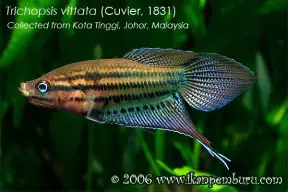
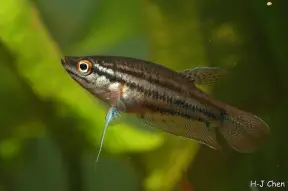
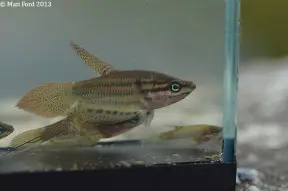
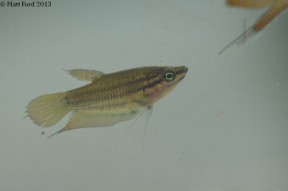
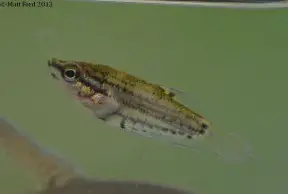

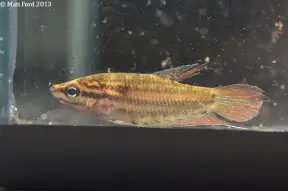

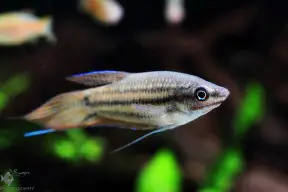
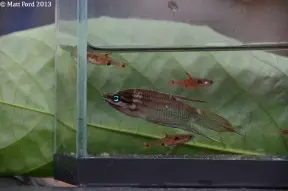

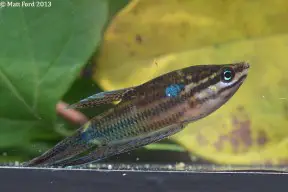

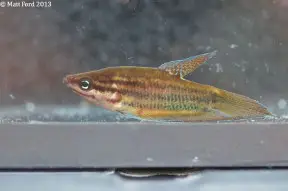
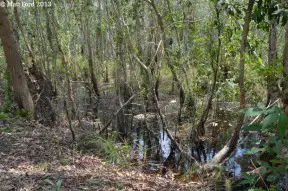
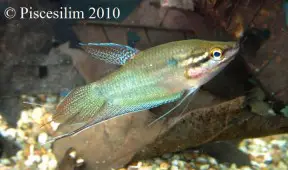
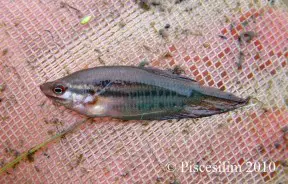
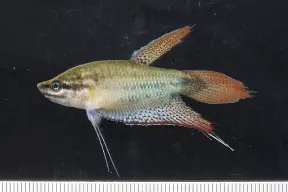
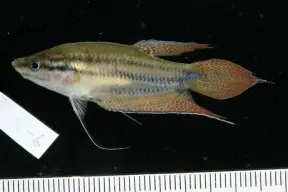
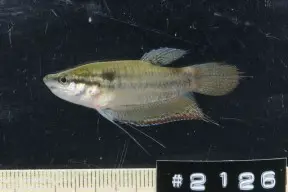
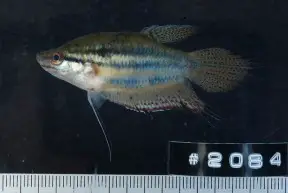
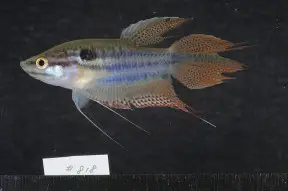
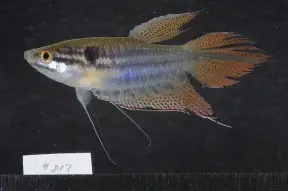
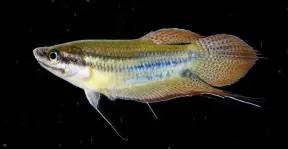
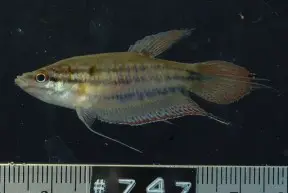

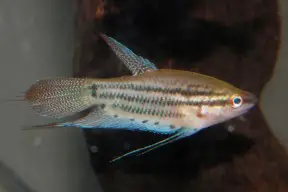
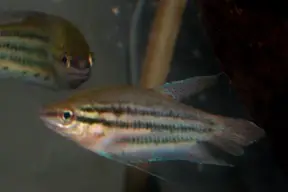
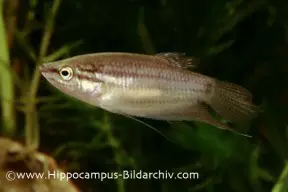

January 31st, 2014 at 10:12 pm
Food:
-My T.vittata srub and eat algae growing on decomposing leafs. They seem to like it. Apart from that I feed them with various living microorganisms.
Behaviour:
-They seem to enjoy the other fish of it’s genus. It allows them to blow off some steam. There is some agression between consepcifics, though. They spare frequently :). Females and males alike, but only between the same sex.
Sexual dimorphism:
-Are You sure of that what You wrote? Some suggest something opposite:
http://aquaticadinatura.blogspot.com/2009/11/guramis-croadores-trichopsis-vittata.html
February 10th, 2014 at 11:04 pm
Update:
When kept in a tank large enough to be considered their territory they become very agressive towards conspecifics. Especially female tries to get rid of other females and males she is not satisfied with.
I think it is safe to assume that given 60x30x30 is enough for a pair of these. They can be kept in smaller aquaria though. For more males and females one should probably prepare an aquarium longer the 100cm.
February 20th, 2014 at 10:51 am
The reproduction part is wrong at one point:
The female may not be removed from spawning site. Right now my pair is caring for their young simultanously. These are two spawns one happened five days after the first. The female is collecting 10 days old fish from the front of the aquarium and transporting them to the males nest.
At first i thought that she was eating them, but since her tummy stayed the same size for 15 minutes I watched them for longer period of time and saw, that she was actually releasing the spawn under the nest.
February 20th, 2014 at 11:35 am
A translating mistake:
may not be removed from–> can be left at.
October 15th, 2015 at 1:44 pm
Now updated.